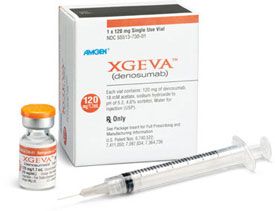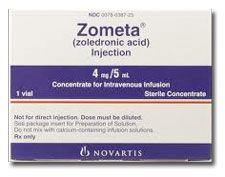Publication
Article
Cost/Benefit Ratio of Denosumab Is Questionable When Treating Patients With Metastatic CRPC
Author(s):
The use of denosumab to prevent SREs in men with mCRPC has questionable cost-effectiveness as compared with zoledronic acid.

The use of denosumab to prevent skeletal-related events (SREs) in men with metastatic castrationresistant prostate cancer (mCRPC) has questionable cost-effectiveness as compared with zoledronic acid, according to an analysis of mathematical models presented in June at the ASCO meeting.
The analysis showed an estimated cost per quality-adjusted life year (QALY) of about $1.25 million for denosumab, far above the $50,000 to $100,000 threshold traditionally used to define cost-effective therapy.
“This high cost per QALY is due to the higher drug acquisition cost of denosumab, combined with the limited prevention of SREs and lack of overall survival [OS] or disease progression benefits versus zoledronic acid,” said Sonya J. Snedecor, PhD, of Pharmerit North America in Bethesda, Maryland, and colleagues. “This analysis raises questions about the cost/benefit ratio of denosumab in metastatic castration-resistant prostate cancer.”
Late last year the FDA approved denosumab for the prevention of SREs associated with metastatic solid tumors. Evidence supporting the monoclonal antibody’s use in CRPC came from a phase III clinical trial that demonstrated the superiority of denosumab versus zoledronic acid for prevention of SREs (N Engl J Med. 2011;377:813-822).
Given denosumab’s higher cost per injection ($1650) compared with zoledronic acid ($886), Snedecor sought to compare the 2 bone-protecting therapies with respect to cost-effectiveness. Using data from the phase III trial, investigators developed a Markov model to estimate the following:

- SRE incidence by type and location
- QALYs
- SRE-related costs
- Drug-related costs, assuming patients received denosumab 120 mg or zoledronic acid 4 mg for up to 27 months
Key model inputs included OS of 34.2% at 27 months with both therapies; probability of a first SRE of 40.3% with denosumab and 45.5% with zoledronic acid; and subsequent on-study SRE per patient of 1.04 with denosumab and 1.29 with zoledronic acid.
Other factors included in the calculations were impact of SREs on quality of life, SRE distribution, persistence with treatment (50% attrition at 10.5 months with zoledronic acid and 13 months with denosumab), and costs. Investigators assumed a pathologic fracture rate of 40% with denosumab and 30% with zoledronic acid; spinal cord compression incidence of 7.6% and 9.3% with denosumab and zoledronic acid; bone surgery in 0.30% and 1.00%; and bone radiation in 51.9% and 52.6% of patients.
The primary outcome was discounted cost per QALY gained. An intervention was considered cost effective if the cost per QALY was less than $100,000.
The base-case analysis yielded a cost per QALY of $1,248,051 for denosumab. Probabilistic sensitivity analysis (PSA) showed a median cost per QALY gained with denosumab of $1,076,827. PSA also showed uncertainty surrounding the QALY benefits of denosumab, as the mean gain was 0.0046 QALY but with overlapping confidence intervals.
“There was less uncertainty that denosumab is more costly than zoledronic acid,” the investigators noted. “As a result, only 18 of 5000 (0.36%) PSA simulations had a cost per QALY ≤$100,000. In 21.2% of simulations, denosumab resulted in fewer QALYs and higher cost compared with zoledronic acid, meaning that zoledronic acid dominated denosumab in one-fifth of the PSA simulations.”
Snedecor SJ, Carter JA, Kaura S, Botteman M. Costeffectiveness of zoledronic acid versus denosumab in prevention of skeletal-related events in castration-resistant prostate cancer metastatic to the bone. J Clin Oncol. 2011;29(suppl; abstr 4581).










